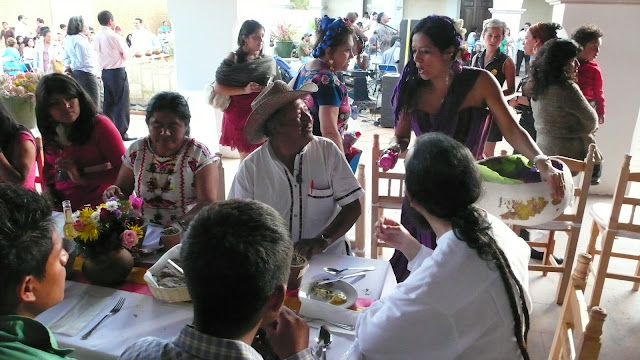
Here's what I did last weekend.
Very early on Christmas Eve, La Noche Buena, I flew from Oaxaca home to Mérida and from here drove out to be with friends in a small Yucatán pueblo. After receiving arrival handshakes from the men and kisses on the cheek from the women, I was served tacos of relleno negro and wonderful pibil-style turkey. The animal, which had been raised in the back yard, was killed earlier in the day and cooked in the traditional Mayan way, wrapped in banana leaves, placed on a bed of hot coals and rocks at the bottom of a hole, and covered with branches, leaves and earth.

At one point in the evening, a prodigal son, who in recent years rarely had visited home and was not expected, suddenly arrived, to the great joy of his parents and sisters. It was a beautiful and touching moment. The party shifted into high gear.
After eating many servings of food followed by dessert, then lingering late over a few caugamas (liter bottles) of beer, the family group, consisting of a pair of elder parents, their numerous children, and some grandchildren, nieces and nephews, slowly began to hang hammocks throughout the small house and drift off to sleep. I was given a place of honor -- a hammock hung in a corner, near one of the two fans in the house -- in a room with seven other hammocks. A few family members stayed up very late drinking and talking in the back, and only lay down to sleep when hammocks were left free by the early risers.
On Christmas morning we sat around the table and drank coffee, ate leftovers, which had been boiled -- no fridge here -- and took a walk in the monte to observe wildflowers and visit a cenote. Later I helped hang new window screens, which were my holiday gift to these friends. I received a pair of beautiful, handmade pillowcases from the "mom" of the house. After a bucket bath, more food and a lazy afternoon siesta rounded out my relaxing "pueblo Christmas."

After resting in chairs placed in the shade of large umbrellas, listening to live music and being served appetizers and more refreshments, we were ushered inside the large casona to lunch. Seated at long tables we dined on a delicious mole as a jazz ensemble played. This was the first of five different bands to entertain us this day, one set each. Jazz was followed by a Oaxacan brass band, then pop music, Oaxacan dancers, and more traditional music.
At one point in the afternoon I was invited onto the dance floor by Lila. Later, I danced as she sang La Sandunga from the floor nearby. Lila Downs has been my favorite performer and recording artist of Mexican music for many years. For a long-time admirer and follower of her music, these unexpected experiences were right up there with the best of Christmas gifts.
After about ten hours of fiesta I had to call it a night in order to get ready for an early morning flight back to Mérida and my pueblo Christmas, but as I said my goodbyes at midnight it seemed that the party was just warming up. I've enjoyed few such events more and was sorry to leave.
I had two very different experiences in different parts of the country last weekend, but they had much in common: the abundant hospitality, warmth, sharing of important traditions, and genuineness of the people were all very much the same. They were both wonderful celebrations. I feel blessed to be able to walk with equal comfort here in many circles.
To all of my friends and readers, Happy New Year.












